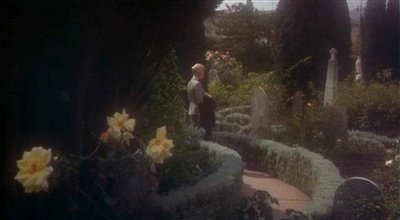I had an idea that when we visited Biltmore House last Friday I’d just nip over to the library and have a good look around, and then we’d venture off to the gardens. But the tour though the house is more regulated than it used to be. As I remember it, you used to be able to sortie out a little bit on your own; but as it is now, you shuffle in a line on a prescribed one-way route through all four floors of the house, every so often pooling in an inlet to a particular room. No nipping, no darting, no backtracking. It’s a well-organized tour, and I salute the estate’s curators for succeeding where many other museums and historic sites have failed, by keeping me on track and in the main exhibit area and not off in some custodial closet or dead-end hallway or any of the other places I usually end up when left on my own to navigate– but it’s a little confining, especially for a repeat visitor.
This meant I revisited a lot of rooms I hadn’t intended to. Not the worst thing but I was glad I’d reminded myself that morning about Henry James’s comments about the house: Whenever I was going through a room I wasn’t particularly interested in, I’d imagine Henry there looking disagreeable. The banquet hall — an enormous, anachronistic room with great tapestries and flags on the walls and heads of deer and moose looking down — has a Skinner pipe organ that occasionally blasts away, and it was nice to think of the dyspepsia it must have given Henry at his dinner.
 Another change: The estate’s library is long and rectangular, and I believe you used to be able to traverse the length of it. Now visitors are kept to one end, while the majority of the books are on display on the other end, too far away to be able to see any of the titles. I craned, but it was no good. It was like trying to read something from across a ballroom. “You should have brought binoculars,” Lowell said.
Another change: The estate’s library is long and rectangular, and I believe you used to be able to traverse the length of it. Now visitors are kept to one end, while the majority of the books are on display on the other end, too far away to be able to see any of the titles. I craned, but it was no good. It was like trying to read something from across a ballroom. “You should have brought binoculars,” Lowell said.
I was curious about the collection because it’s supposed to be an unusually good one. Vanderbilt was a great reader and an avid collector of rare books. So the library wasn’t assembled just for show, with one of those bought-in-lot collections that look impressive at first glance but are really dreary on closer inspection, all Julia, Country Nurse with a Heart and Prize-Winning Sheep of Hertfordshire, 1918, etc. But while you hear many numbers attached to Biltmore’s collection — the two most cited being: that there are more than 23,000 volumes in all (with about 10,000 displayed in the library), and that Vanderbilt started keeping a list when he was 12 of the books he’d read, and at the time of his death (at 52) the list was 3,159 books long — details about the books themselves are harder to come by. I remember odd bits about the books from previous visits but I meant to record a little more on this trip.
As I said, the library’s a long room with a high ceiling. Overhead is a ceiling painting by Pellegrini, The Chariot of Aurora, which came to the estate from a palace in Venice. A second level of books is reached by a spiral staircase. The shelving and paneling are walnut, and there’s a good amount of natural light from windows and French doors that lead out to the patio. The couches and chairs are elegant although maybe not as comfy and luxe as you might expect. Off to one side is a giant globe, which I think we can all agree no self-respecting library should be without.
The part of the collection that was within my sight was beautifully bound, with lots of reds, golds and browns. On one low shelf were the “magnum” oversized books, mostly about art, including:
• A five-volume set of Fables de Fontaine bound in a gorgeous leaf green
• Two volumes of Drawings of the Florentine Painters
• Carter’s Ancient Paintings and Sculptures in England
• Gainsborough Works
• Two volumes on The Royal Collection of Paintings, with volume one devoted to Buckingham and volume two to Windsor
• A multi-volume set stamped in gold leaf with titles like Specimens of Ancient Sculpture, Penrose’s Athenian Sculpture, and Ionian Antiquities by the Dilettanti, my favorite title of the day.
A representative smattering of titles from the shelves above:
• A two-volume set of Godwin’s Life of Chaucer
• Musical Instruments
• Auguste Rodin: L’Oeuvre et L’Homme by Judith Cladel
• Glimpses of Italian Court Life
• Holbein’s Court of Henry VIII
• A 45-volume set, bound in a bright cherry red, of L’Art
• Le Livre D’or de Victor Hugo shelved next door to a five-volume set on History of the Indian Tribes of the United States, right where you’d look for it
• And bound editions of Country Life magazine dating from 1896 to 1904 (this tickles me, as it both describes and completely fails to describe what Vanderbilt set up for himself at Biltmore)
The room’s attendant, who was lovely, told me many of the rarer books are kept on the third floor of the house, which is climate-controlled. The hallway where this part of the collection is displayed is darker, so it was harder to make out titles — also, my companion was looking a little rebellious — but I was taken by one shelf of books by Andrew Lang, including The Blue Fairy Book, Green Fairy Book, Yellow Fairy Book, Violet Fairy Book, The Animal Story Book, and The Book of Dreams and Ghosts.
The estate offers a number of specialty tours, and I wish they’d start a Library Tour, where you’d get to romp around the library beyond the cordon as well as handle some of the books, to look at the illustrations, read a little, and maybe huff at the bindings when the curator was discreetly turned away.
PLAY
Richard III (Strawdog Theatre, 3829 N. Broadway, Chicago, closes Mar. 29). Nic Dimond’s lean, mean production of Richard III is anchored by a charismatic title role performance by Strawdog ensemble member John Henry Roberts and a soulful one by Jennifer Avery as Queen Elizabeth. The fine supporting cast barely fits all at once in Strawdog’s tiny performance space, but Joe Schermoly’s pared-down set makes the most of the claustrophobia. All in all, electrifying (OGIC)
TT: Almanac
“California is a place in which a boom mentality and a sense of Chekhovian loss meet in uneasy suspension; in which the mind is troubled by some buried but ineradicable suspicion that things had better work here, because here, beneath that immense bleached sky, is where we run out of continent.”
Joan Didion, “Notes From a Native Daughter”
PLAY
The Trip to Bountiful (Goodman Theatre, 170 N. Dearborn, Chicago, closes Apr. 6). A Chicago revival of the off-Broadway production that was the talk of Manhattan playgoers two seasons ago. I praised it to the skies in The Wall Street Journal: “Horton Foote’s The Trip to Bountiful is fully as worthy of regular revival as Our Town or The Glass Menagerie, and this production, directed by Harris Yulin and acted with quiet skill by Lois Smith and the best ensemble cast in town, leaves no doubt of its special quality….I doubt you’ll ever see it performed better, especially by Smith, whose acting is so beautifully straightforward that you feel as though you’re eavesdropping on her.” It should have transferred to Broadway, but no theaters were open at the time, so instead it’s being presented a second time as part of the Goodman Theater’s Horton Foote Festival. Do not miss this extraordinary show under any circumstances, no matter how far you have to drive, fly, or ride a bus in order to see it (TT).
TT: Speed demon
 On Friday Mrs. T and I took the Coast Starlight from Los Angeles to San Francisco. We spent eight hours of our eleven-hour trip sitting in the Sightseer Lounge Car, noshing on deli sandwiches from Canter’s and looking out the window at the most beautiful view in California, or maybe the universe.
On Friday Mrs. T and I took the Coast Starlight from Los Angeles to San Francisco. We spent eight hours of our eleven-hour trip sitting in the Sightseer Lounge Car, noshing on deli sandwiches from Canter’s and looking out the window at the most beautiful view in California, or maybe the universe.
The only blot on the day was the intermittent presence of a teenager with a cellphone, a penetrating voice, and no interest in scenery:
TEENAGER WITH CELLPHONE So I’m like, I totally did not sleep with him! Woh! Eeuuww! Hel-lo!
ME (muttering grumpily) Stupid California robot girl.
MRS. T (stroking my arm soothingly) Don’t be negative, darling.
ME I’d like to nail her tongue to her forehead.
Otherwise it was bliss.
 We spent the weekend seeing shows in San Francisco and Berkeley. We’re staying at the Hotel Diva, which is handily located across the street from one of the shows I came to town to review. Our room, as befits the name of the hotel, is…well, let’s just call it extensively decorated. No sooner had the bellman dropped off our bags than we discovered a printed list of official Diva Dos and Don’ts over which we’re still giggling: DO throw on a cuff bracelet to complete an outfit. DON’T forget a smile is still the ultimate accessory.
We spent the weekend seeing shows in San Francisco and Berkeley. We’re staying at the Hotel Diva, which is handily located across the street from one of the shows I came to town to review. Our room, as befits the name of the hotel, is…well, let’s just call it extensively decorated. No sooner had the bellman dropped off our bags than we discovered a printed list of official Diva Dos and Don’ts over which we’re still giggling: DO throw on a cuff bracelet to complete an outfit. DON’T forget a smile is still the ultimate accessory.
 On Saturday we shopped and paid a visit to the de Young Museum, which I saw for the first time a year ago. I feel the same way now as when I wrote about it then: the building is remarkable, the collection spotty but by no means without interest, especially if you’re into Richard Diebenkorn. Then we went to a late-afternoon service at Mission Dolores, where one of my blogfriends is the organist. Non-San Franciscans know the church from Alfred Hitchcock’s Vertigo, in which it figures prominently.
On Saturday we shopped and paid a visit to the de Young Museum, which I saw for the first time a year ago. I feel the same way now as when I wrote about it then: the building is remarkable, the collection spotty but by no means without interest, especially if you’re into Richard Diebenkorn. Then we went to a late-afternoon service at Mission Dolores, where one of my blogfriends is the organist. Non-San Franciscans know the church from Alfred Hitchcock’s Vertigo, in which it figures prominently.
 The Old Mission, which was built in 1791 and is the oldest surviving structure in San Francisco, makes a very different impression when filled with ordinary churchgoers than when you see Jimmy Stewart and Kim Novak passing through it on the way to the graveyard in back. In Vertigo it is subtly glamorized, if only by the presence of famous faces. In regular use it is no less beautiful, but also homelier–in every sense of the word. I was astonished, for instance, to see that the same man who had rented me a car only a few hours earlier was sitting three pews ahead of us. Perhaps I shouldn’t have been: San Francisco is like that, a thoroughly, even self-consciously cosmopolitan community whose scale and pace are nonetheless far removed from the frenzied bustle of Manhattan.
The Old Mission, which was built in 1791 and is the oldest surviving structure in San Francisco, makes a very different impression when filled with ordinary churchgoers than when you see Jimmy Stewart and Kim Novak passing through it on the way to the graveyard in back. In Vertigo it is subtly glamorized, if only by the presence of famous faces. In regular use it is no less beautiful, but also homelier–in every sense of the word. I was astonished, for instance, to see that the same man who had rented me a car only a few hours earlier was sitting three pews ahead of us. Perhaps I shouldn’t have been: San Francisco is like that, a thoroughly, even self-consciously cosmopolitan community whose scale and pace are nonetheless far removed from the frenzied bustle of Manhattan.
Afterward Mrs. T and I took our organist friend out to dinner at Zuni Cafe, which needs no introduction to cookbook-collecting foodies, and ate very, very well. Should you go there, make a point of ordering something–anything–that has anchovies in it. Unless you have major anchovy-related issues, you won’t be sorry.
Sunday was devoted to more playgoing, interspersed with meals shared with two other bloggers. Today we breakfast with yet another blogfriend, followed by a cable-car ride and whatever else tickles our mutual fancies. Tomorrow we fly back to New York, just in time, since we’re both starting to feel a bit worn from our nonstop adventures.
And then? On Wednesday I write, followed by a taping with a CBS camera crew (about which more later, maybe) and a trip to Studio 54 to see Sunday in the Park with George. On Thursday I write. On Friday I write. On Saturday I write and see Passing Strange. On Sunday I write and see Adding Machine….
It’s a living.
P.S. Yes, we ate at Pink’s. And it was good.
TT: Almanac
“In San Francisco, vulgarity, ‘bad taste,’ ostentation are regarded as a kind of alien blight, an invasion or encroachment from outside. In Los Angeles, there is so much money and power connected with ostentation that it is no longer ludicrous: it commands a kind of respect. For if the mighty behave like this, then quiet good taste means that you can’t afford the conspicuous expenditures, and you become a little ashamed of your modesty and propriety.”
Pauline Kael, I Lost It at the Movies
TT: Importantitis, enemy of art
In today’s Wall Street Journal “Sightings” column I consider the careers of Leonard Bernstein, Orson Welles, and Ralph Ellison. All were artists of extraordinary promise who failed to live up to it. What went wrong? Each of them contracted the same dread disease:
Stephen Sondheim, Bernstein’s collaborator on “West Side Story,” told Meryle Secrest, who wrote biographies of both men, that he developed “a bad case of importantitis.” That sums up Bernstein’s later years with devastating finality. Time and again he dove head first into grandiose-sounding projects, then emerged from the depths clutching such pretentious pieces of musical costume jewelry as the “Kaddish” Symphony and “A Quiet Place.” In the end he dried up almost completely, longing to make Great Big Musical Statements–he actually wanted to write a Holocaust opera–but incapable of producing so much as a single memorable song.
Alan Greenspan recently proposed a constitutional amendment: “Anyone willing to do what is required to become president of the United States is thereby barred from taking that office.” In a similar spirit–with tongue partway in cheek–I’d like to put forward Teachout’s First Law of Artistic Dynamics: “The best way to make a bad work of art is to try to make a great one.” That law was inspired at least as much by Orson Welles as by Bernstein….
Read the whole thing here.
CAAF: Field trip
It’s been a busy week with an unexpected flurry of deadlines. Lowell has a bad cold and looks and sounds like a mournful frog. The nice thing: We’re playing hooky this morning. A friend gave us passes to Biltmore Estate, the French chateau that George Vanderbilt chose to build in Asheville. How unlikely it was that Vanderbilt would build here — in some remote mountain town, only newly reachable by train, far from friends and family — never occurred to me until I was researching Henry James’ and Edith Wharton’s stays at the estate for an article I wrote several years back. Here is James in a letter to Wharton:
We are 2,500 feet in the air; the cold, the climate, is well nigh all the ‘company’ in the strange, colossal heart-breaking house; & the desolation & discomfort of the whole thing — whole scene — are, in spite of the mitigating millions everywhere expressed, indescribable. … It’s, in effect, like a gorgeous practical joke — but at one’s own expense, after all, if one has to live in solitude in these league-long marble halls.
When I first moved here and knew hardly anyone, I spent a lot of time mooning around the estate, although tellingly the part I feel most at home in is the servants quarters, which are very simple and airy and remind me of my grandparents’ farm. Today I’m looking forward to visiting the library (duh) and exploring the grounds, although I imagine they’re a little stark and wind-swept this time of year. The estate was Frederick Law Olmsted’s last great project, and this will be my first time visiting since reading a couple books by and about him.
